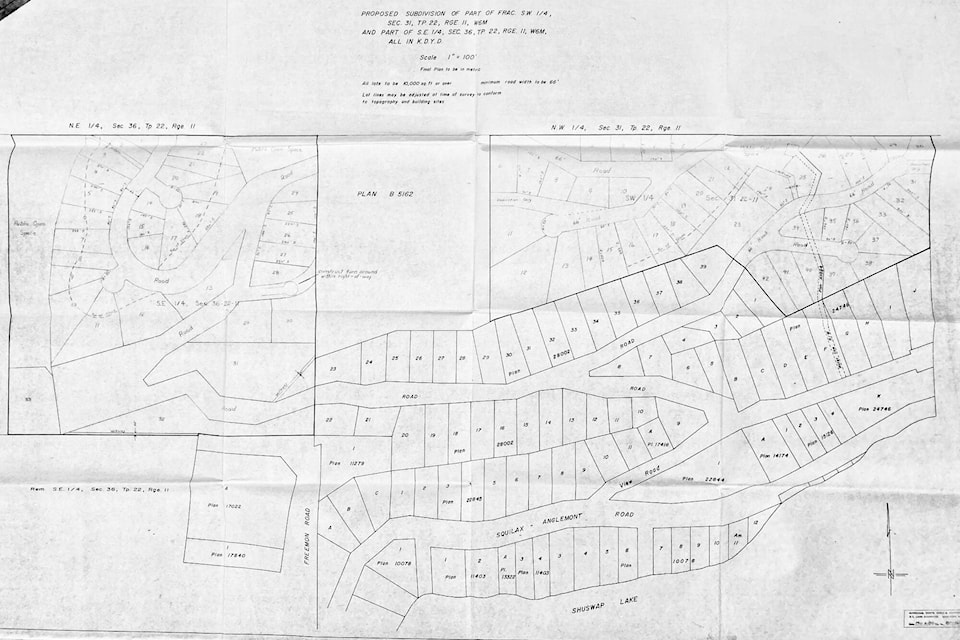This is the second part in a two-part series that began with Recounting the saga of Lee Creek Heights.
Mike Riley began his subdivision in earnest, with plans for three phases.
The first phase, which began in 1973, focused on the highway and View Road, where his mother Beatrice had already sold a few lots on the lake side of the road.
Due to the steep hillside on the northside, the building sites were located above the road.
While the address for these lots was on View Road, the actual access was a narrow unpaved alley off of Hopwood Road. Likely the first house built in the first phase is the home below the cliff on the north side of View.
To market the lots, a small sales office was built on the highway across from the water intake. It quickly became obvious that the office was not attracting much attention from the highway traffic, so it became a storage building.
Despite the low prices for the lots, between $2,000 and $3,000, sales were slow as many were purchased as investments by Mike’s friends and associates.
Once the water pipes were laid, marketing began for the second phase along both Hopwood and Lee Creek Drive. Tom Campbell built one of the first homes in the second phase on the corner lot where Hopwood meets Lee Creek Drive for a teacher, Jean Lindsey, from Haldane Elementary. Crichton Campbell, Tom’s son, purchased his first lot in 1978, and by that time the lot price had increased to $8,000.
The third phase presented many challenges, beginning with building the road up the steep hillside to the switchback, where Mike had set up a gravel crusher to provide road mulch.
When the first attempt was rejected by the ministry of highways and transportation for being too steep, Mike had to bring in a compressor for blasting the rock. After a second attempt was rejected, it took more blasting and bulldozing until the ministry was satisfied with the grade.
The major challenge for the third phase was developing a water supply, as the proposed lots were higher than the water tanks installed for the first two phases.
Mike managed to obtain a water licence for a substantial supply from Freeman Brook and he obtained a lease from the government for one acre of land below the bluff for a reservoir.
Read more: Column: Recounting the saga of Lee Creek Heights
Read more: Column: The Shuswap’s back-to-the-landers were an amorphous bunch
In an effort to find a way to access the water, Mike used his bulldozer in an attempt to cut a road from above the bluffs down to where he had cleared the area to store the water. Predictably, his effort to defy the geography failed, as the ground was too steep.
He then cut a ditch from Freeman Brook to his reservoir site, however, that attempt failed too because it is a seasonal creek,1 and the reservoir did not retain the water.
One of the selling features of the Anglemont subdivision in the 1970s was its air strip, and Mike likely thought having one at Lee Creek would benefit sales. The Crown land below the bluff is quite flat and Mike applied for a lease to build an air strip on it.
The government rejected his application for good reasons, one of them being if a plane overshot the runway, it could have ended up in the Lee Creek Canyon.
To this day, we refer to this area as “the airport.” By the end of the 1970s, a great deal of money had been spent paving the roads and installing water pipes for phase three of Lee Creek Heights, with nothing to show for it because the pipes were still dry. Mike needed an out, thus the uncompleted third phase of the subdivision, totalling about 50 acres, was sold to its two major investors, Bernie Gagne and Irwin Eisler. They decided the only way to provide water was to build a concrete reservoir and pump up from the lake. A hole was dug on the leased acre and forms were built, but by this time it was the early 1980s and the economy was in tatters with interest rates at record levels.
With costs rising and no income, the third phase of the subdivision became bankrupt and was eventually purchased from the bank by a group of friends from the upper Lee Creek community. Today, there are homes on most of the original 70 lots in phases one and two, while just 18 families and individuals live on the proposed 40 lots in phase three.
newsroom@saobserver.net
Like us on Facebook and follow us on Twitter
Sign up for our newsletter to get Salmon Arm stories in your inbox every morning.
